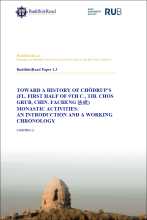BuddhistRoad Paper 1.3 “Toward a History of Chödrup’s (fl. First Half of 9th C.,Tib. Chos grub, Chin, Facheng 法成) Monastic Activities: An Introduction and a Working Chronology”
Synopsis
Building on previous studies, especially those in Japanese and Chinese, this paper is intended as an introduction to Go Chödrup’s (fl. first half of 9th c., Tib. ’Go Chos grub, Chin. Facheng 法成) monastic career through a wide-ranging survey of primary sources from Dunhuang. Apart from offering an outline of Chödrup’s translations from Chinese into Tibetan, which are relatively better known to Buddhist scholars, this paper further conducts a preliminary study of Chödrup’s translations from Tibetan and Sanskrit into Chinese. This part of the research, presented in section 2, highlights Chödrup’s mastery of the three languages and his efforts in promoting the cross-cultural fertilisation of diverse Buddhist teachings in Dunhuang. Section 3, devoted to the commentaries and lecture notes produced by Chödrup, casts a spotlight on his identity as a Buddhist scholar who integrated various doctrinal schools in contemporary India, Tibetan, and Chinese Buddhist circles into his own teachings. The two active intellectual lineages of Vasubandhu’s (3rd–4th c.?) Yogācāra teachings—one being Xuanzang (600/602–664, 玄奘)-Wonch’uk (613–696, 圓測)-Tankuang (ca. 700–ca. 785, 曇曠) lineage, the other that of Kamalaśīla (ca. 740–ca. 795) and other intermediate Indian masters (such as Jñānadatta)—converged in Chödrup’s oeuvre. The survey of Chödrup’s works also yields a working chronology of his monastic activities, which provides a clearer historical context for these works and more vividly reflects the localisation of Buddhism in Dunhuang as part of a larger network of Buddhism in Eastern Central Asia involving the in-depth interaction and synthesis of diverse Buddhist teachings ranging from Indian to Tibetan and Sinitic influences.
Chinese Translation
在充分參考現有學術成果並廣泛利用敦煌出土文獻的基礎上. 本文旨在對吳法成 (藏文: ’Go Chos grub, 活躍於九世紀上半葉) 的僧侶生涯進行綜述性研究. 除了探討廣為人知的法成由漢文翻譯成藏文的譯經史外, 本文還整理了法成從藏文, 梵文翻譯成漢文的翻譯歷史. 透過研究他作為佛教翻譯家的成就 (參見本文第二部分), 展示了法成對梵, 藏, 漢三種語言的精通熟稔, 同時亦集中體現了他在敦煌佛教跨文化蓬勃發展中的重要角色. 本文的第三部分則聚焦於法成作為一名融會貫通印, 藏, 漢佛學思想的學者 (而非僅僅是翻譯家) 這一身份, 整理並討論了其所撰寫的佛教注疏及由弟子記錄下來的講義稿. 法成的論著集中體現了其對該瑜伽行派的精通. 由世親開創的瑜伽行派思想的後期傳播有兩大脈絡: 一是玄奘—圓測—曇曠的法相宗一派, 在漢地廣為流行; 另一支是由蓮花戒 (Kamalaśīla) 集大成, 後由印藏僧侶 (例如智威 Jñānadatta) 繼續發展, 主要流行於印度和藏地. 法成的論著集中體現了其對該二脈的融會集成. 本文同時擬構出法成佛教活動的年代表, 旨在為法成佛教翻譯和注疏論著的整理研究提供更清晰的歷史背景信息, 同時也生動體現了佛教在敦煌的本地化發展, 展現了不同佛教文化, 包括印度, 藏地和漢地, 在整個中亞東部地區傳播網絡中廣泛而深刻的互動交融.

Downloads
Published
Categories
License

This work is licensed under a Creative Commons Attribution-NonCommercial-NoDerivatives 4.0 International License.

